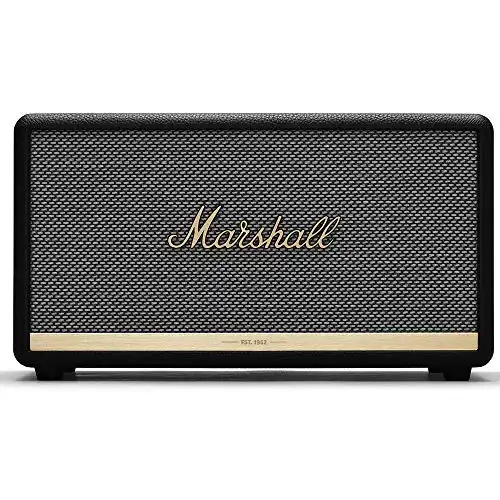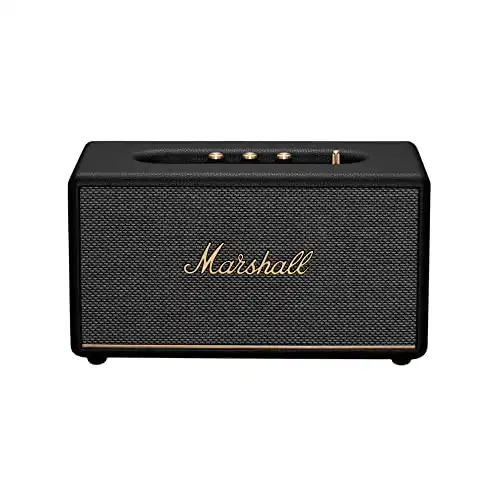Anybody that knows music, even a little, surely is familiar with the Marshall name and iconic design.
And anybody that knows bluetooth speakers is surely familiar with cheap, plastic products that barely seem built to outlast their 12 month manufacturer’s warranty.
So when Marshall decides to apply their vintage styling and high quality designs to a bluetooth speaker — audiophiles, tech reviewers, and everyday consumers are understandably excited to test the products.
Here, we will compare mid-size, non-portable options of differing generations, and see how the Marshall Stanmore 2 compares to the newer iteration, the Marshall Stanmore 3.
|
|
|
Summary
For the most part, the Stanmore 2 and Stanmore 3 are similar speakers.
The high sound quality remains largely unchanged, but the soundstage is slightly wider on the 3 thanks to tweeters that are angled outwards.
Bluetooth is updated to version 5.2 on the Stanmore 3, whereas the Stanmore 2 had version 5.0. Stanmore 3 also adds a track skip button, rather than just the simple play/pause button that was present on the Stanmore 2.
Other than these changes and a few minor changes we will discuss below, the Stanmore 2 and Stanmore 3 are almost identical.
If you are looking to purchase a new speaker, the Marshall Stanmore 3 is objectively better than the Stanmore 2. However, the margin is so small that it is not worth your money to upgrade from the 2 to the 3 if you already own the Stanmore 2.
At full MSRP (>$350), these speakers feel slightly overpriced. There isn’t anything wrong with either, it’s just that you want to be blown away by speakers when your budget is north of $300.
Admittedly, the $250-$400 price range (where the Stanmore operates) is something of a black hole in the speaker market.
The Marshall Woburn is a clear upgrade over the Stanmore, but it runs north of $500. Moving in the other direction, the sub-$300 Marshall Acton is an excellent speaker but can’t provide as much volume or overall output as the Stanmore.
So, there is definitely an argument to be made for either version of the Marshall Stanmore, especially if you can find one available at a discount.
~~~ Check Price: Marshall Stanmore 2 ~~~
~~~ Check Price: Marshall Stanmore 3 ~~~
Sound
If you like the sound quality of Stanmore 2, the newer Stanmore 3 will not disappoint.
Marshall’s marketing material for the 3 focused on the improved soundstage, and thankfully Marshall actually delivered in this regard. The tweeters are positioned with a wider angle on the 3 than the 2, and in testing you can truly hear a difference.
If immersive sound is your priority, the Stanmore 3 is a clear upgrade.
Features like “Placement Compensation” (similar to Bose’s PositionIQ) and “Dynamic Loudness” don’t really move the needle.
The placement compensation feature is controlled through the app, and basically functions to modify the equalizer settings if there are obstructions nearby the speaker.
Dynamic loudness, on the other hand, changes the equalizer based on the speaker’s volume, in an attempt to find the right sound balance at any level.
Although these features are great marketing material, both seem a bit gimmicky at this point in time.
The Stanmore 2 and Stanmore 3 both have equalizers that can be controlled right from the device, with knobs for bass and treble on the top control panel. This is an unusual feature for a bluetooth speaker, and we give Marshall a lot of credit for including this.
Sound quality is balanced and crisp on both speakers, without much difference on the newer iteration. The Stanmore 2 seems to get slightly louder than the 3, but the difference will only be observable during side-by-side testing.
Most users, myself included, enjoy the out-of-the-box sound profile enough to render the EQ unnecessary. Both versions of the Stanmore sound great, but maybe not “almost $400 great.”
Sound winner: Stanmore 3 (slight improvement due to wider soundstage)
Design
Design and build quality are the areas where Marshall justifies the expensive price tag.
Testing bluetooth speakers can sometimes feel monotonous – an endless sea of cheap plastic and fabric. But any Marshall speaker turns this trend upside down.
Both the Stanmore 2 and 3 (as well as every speaker in the Marshall lineup) have the classic Marshall guitar amp design for a stylish, retro look. These speakers are solid, sturdy, and well built in every way.
Rather than the cylindrical, soda can styling of many portables, the Stanmore is a rectangular speaker that is built to sit on a bookshelf rather than being clipped to a backpack or thrown in a gym bag.
*On the above note, it should be pointed out that both the Stanmore 2 and 3 require a permanent power source. These are not portable speakers with built-in batteries.
Both speakers have the same input options – a 3.5 mm aux port, RCA inputs, and bluetooth-capability. The speaker appearance is nearly identical, as well. The control panel is located on the top of both speakers, and again is almost identical.
In regards to controls, the only noteworthy difference is that the Stanmore 3 adds the play/skip track control in addition to the play/pause control. On the Stanmore 2, only play/pause is present on the device. The controls/knobs on both speakers have a great feel and really enhance the user experience.
Both the 2 and 3 have a power button, input ports, and bass/treble/volume knobs on the top of the device.
The Stanmore 3 has a greater emphasis on sustainable materials, with Marshall stating that the speaker is made of recycled plastic, contains no PVC, and uses “vegan materials” (in other words, the leather exterior isn’t actually leather).
Some users will also notice that the rear plate on the Stanmore 3 is made of plastic, whereas the Stanmore 2 had a steel plate (in the earlier versions).
While this seems like a downgrade, it really doesn’t make much of a difference. In fact, it contributes to the decreased product weight of Stanmore 3.
Design winner: Stanmore 3, by only a tiny margin
Durability
The durability discussion will be fairly limited, since the Stanmore 3 is new to the market.
But there are quite a few things we do know.
First, the Stanmore 2 continues to be a reliable speaker as it approaches its 4th birthday.
Second, Marshall generally makes reliable products that last longer than competitors.
Third, the lack of a built-in battery greatly increases the expected lifespan of these speakers.
Small batteries, especially those that experience the drain/recharge cycle on a repeated basis, are destined to fail. The Stanmore, on the other hand, avoids this risk by relying on a constant power source instead.
Having said all of the above, we rate the durability of the Stanmore 2 and Stanmore 3 essentially equal. Stanmore 2 has the four year track record of success, whereas Stanmore 3 hasn’t yet been proven.
However, the build quality and design of both speakers is so similar that I don’t expect the Stanmore 3 to suffer durability issues. The speaker box is solid, the product is well-built, and the faux leather exterior holds up well over time.
Because the speakers aren’t “portable,” per se, the exposed knobs, plastic backing, and speaker cover shouldn’t be subjected to much wear and tear.
Stanmore 3 features more recycled plastic, which may prove to be a durability concern over time. But we honestly just trust that Marshall knows what they are doing.
Durability winner: Stanmore 2 is a slight winner since it has a track record of success
Battery
This section will also be brief, but with an important note.
Neither the Stanmore 2 or 3 has a built-in battery. While we generally think of bluetooth speakers as portable, the Stanmore is more of a bookshelf speaker that is bluetooth-enabled.
On the downside, the lack of a built-in battery means the speaker isn’t particularly portable.
However, the fact that it has multiple, easy-to-use connection options, as well as a power cable, means that there is still some degree of portability. It isn’t stuck in place like a home stereo, but instead can easily be moved anywhere with a power outlet.
On the upside, it should be acknowledged that built-in batteries are extremely common sources of speaker failure. So, if you are buying a speaker with the intention of using it for 5+ years, this usually won’t be realistic with a portable speaker.
On the other hand, the Stanmore should hold up for quite a few years with no concerns about battery degradation. As an example, the Stanmore 2 has been on the market since 2018, and there are thousands of satisfied customers using the speaker almost 4 years later.
If you need a speaker that is truly portable, yet you like the Marshall brand and design, consider the Emberton (and Emberton 2) among budget options, and the Tufton among premium choices.
Software
Software is similar between the two devices.
The big differences are that Multistream (essentially just a party mode) is “on its way” to the Stanmore 3, as is a “Broadcast” function that allows you to broadcast audio from the speaker to other devices.
Generally, I don’t get too excited about features that are “coming soon.”
Historically, if the technology is nearly ready, it gets added before the speaker goes to market. There are numerous examples of bluetooth speakers that have had app-compatibility “coming soon” for years – without ever receiving the update.
However, I trust Marshall more than an average, budget bluetooth speaker manufacturer. So my guess is that we will actually see these features in the next 6 months.
Both speakers have an adjustable EQ on a fairly simple app. The Stanmore 3 adds the Placement Compensation to adjust sound settings to compensate for the room environment, but as mentioned above I wouldn’t make a purchase decision based on this feature.
The Stanmore 3 also features the updated Bluetooth 5.2 whereas the Stanmore 2 has the older (but still functional) Bluetooth 5.0.
Bluetooth 5.2 has the potential to make the speaker much more functional by reducing power consumption and improving communication between devices. Essentially, 5.2 should give us the ability to connect to multiple devices simultaneously while also decreasing latency.
Hopefully this new bluetooth version will eliminate some of the lag issues that occasionally affected the Stanmore 2. But for the time being, there just isn’t a huge difference between the functionality of the 2 and 3.
Final Thoughts
|
|
|
Marshall Stanmore 3 provides a refresh and small upgrade, but doesn’t totally redesign or significantly change the Stanmore 2. I view this as a good thing, since the Stanmore 2 was an excellent speaker in its own right.
Both speakers have beautiful and sturdy designs along with high sound quality and EQ knobs right on the device.
Each speaker needs a wired power source, since both lack a built-in battery (Emberton 2 and Tufton are great Marshall speakers that do feature a built-in battery for portability).
If you already own a Stanmore 2, I don’t think the 3 is enough of an upgrade to justify spending almost $400 on the new generation. If you are looking to purchase a Stanmore, go with the Stanmore 3 if the prices are the same, but consider the Stanmore 2 if you can save $50+.
The Stanmore 3 has an upgraded bluetooth (5.2 vs. 5.0 on the Stanmore 2), an added track skip button, and improved soundstage. There are also a couple of added software features that are cool but not entirely necessary. Otherwise, the speakers are nearly identical.
At the full MSRP, which runs north of $350, both the Stanmore 2 and Stanmore 3 feel slightly overpriced. But if you have a few hundred dollars to spend on a powerful, well-designed speaker that also provides good-to-great sound quality, either model is certainly worthy of consideration.



